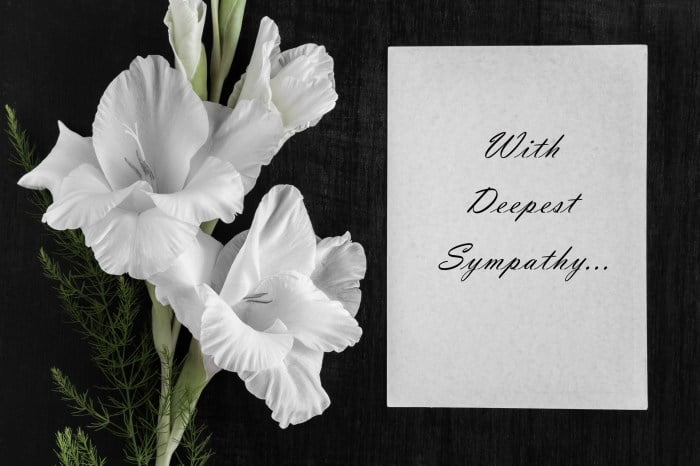In the face of loss, words can sometimes feel inadequate to express the depth of our sorrow and empathy. Yet, it is through these words that we can offer comfort, support, and a sense of shared humanity to those who are grieving.
Crafting a beautiful condolence message is an art that requires a delicate balance of empathy, acknowledgment, and celebration.
As we navigate the complexities of loss, this guide delves into the essential elements of creating meaningful and heartfelt condolence messages. We will explore how to express genuine empathy, acknowledge the loss, celebrate the life lived, offer practical assistance, and remember the deceased in a thoughtful and respectful manner.
By understanding the nuances of cultural and religious considerations, we can tailor our messages to honor the beliefs and traditions of the grieving individual.
Empathy and Support
When offering condolences, empathy and support are paramount. Your words should convey genuine care and understanding for the grieving individual.
Share a personal anecdote or experience that demonstrates your understanding of their pain. This can help them feel less alone and more connected to you during this difficult time.
Expressing Heartfelt Empathy
- Use phrases like “I’m so sorry for your loss” or “My heart goes out to you” to express your sincere sympathy.
- Acknowledge the pain they are going through by saying, “I can’t imagine how difficult this must be for you.”
- Offer a listening ear by saying, “I’m here for you if you need to talk.”
Providing Words of Comfort and Assurance
- Remind them that grief is a natural process and that it’s okay to feel the emotions they are experiencing.
- Offer words of hope and encouragement, such as “This pain will eventually ease” or “You will get through this.”
- Share a quote or a piece of scripture that has brought you comfort in difficult times.
Sharing a Personal Anecdote or Experience
- Share a story about a time when you experienced a similar loss and how you coped with it.
- Talk about a time when someone offered you comfort and support during a difficult time and how it helped you.
- Explain how the memory of your loved one will continue to live on through the stories and memories you share.
Acknowledging the Loss
Acknowledging the loss is a crucial step in the grieving process. Personalizing the message by mentioning the deceased’s name demonstrates empathy and shows that you truly care.
Highlighting the positive qualities or achievements of the deceased is a respectful way to honor their memory and remind the bereaved of the impact they had on others’ lives.
Expressing how much the deceased will be missed conveys your genuine sympathy and acknowledges the void their absence has created.
Using Specific Examples
- “I will always remember [Name] for their unwavering kindness and infectious laughter. They had a gift for making everyone around them feel loved and appreciated.”
- “[Name] was a remarkable educator who touched the lives of countless students. Their passion for teaching and dedication to their students will be deeply missed.”
- “We will miss [Name]’s witty sense of humor and their ability to always brighten up a room with their presence. They were a true friend and will be forever cherished in our hearts.”
Celebrating Life

Acknowledging the life of the deceased is an important part of the grieving process. Instead of dwelling on the loss, we can focus on the impact they had on our lives and the lives of others. By sharing fond memories and anecdotes, we create a sense of celebration of the life lived, honoring the person we’ve lost.
Impact on Others
Take a moment to reflect on the positive impact the deceased had on your life and the lives of others. Consider how they made a difference, big or small. Share these thoughts with loved ones to create a collective tapestry of the person’s influence.
Fond Memories
Share fond memories or anecdotes that capture the essence of the person’s spirit. These stories can bring laughter, tears, and a sense of connection to the deceased. Encourage others to share their own memories, creating a mosaic of cherished moments.
Creating a Celebration
Consider organizing a celebration of life event that reflects the person’s passions and interests. This could be a gathering of friends and family, a memorial service, or a symbolic gesture that honors their memory. By creating a space for remembrance and celebration, we can come together to honor the life that was lived.
Offering Practical Assistance

In times of grief, practical support can be immensely comforting. Beyond offering emotional comfort, you can provide tangible assistance to alleviate some of the burdens they may be facing.
Reaching Out
Initiate contact with the grieving individual, either in person or through a heartfelt message, expressing your condolences and concern. Ask if there are any immediate needs or concerns they may have, showing genuine interest in their well-being.
Remembering the Deceased
Honoring the memory of a loved one who has passed away can be a meaningful way to keep their spirit alive and find comfort during the grieving process. Here are some ways to remember and celebrate the life of the deceased:
Planting a Memorial Tree
Planting a tree in memory of the deceased is a beautiful way to create a living tribute that will grow and thrive for years to come. Choose a tree that has special meaning to the deceased, such as their favorite type of tree or a tree that symbolizes their personality or life story.
Donating to Charity
Donating to a charity in the deceased’s name is a thoughtful way to honor their memory and support a cause that was important to them. Choose a charity that aligns with their values and passions, and consider making a recurring donation to ensure a lasting impact.
Creating a Memorial
Creating a memorial for the deceased can be a tangible way to remember and celebrate their life. This could involve creating a special space in your home or garden dedicated to their memory, or it could involve creating a public memorial such as a bench, a plaque, or a work of art.
Preserving Memories
Preserving memories of the deceased can be a comforting way to keep their spirit alive. Consider creating a memory book or scrapbook filled with photos, stories, and other mementos that remind you of them. You can also create a digital memorial website or social media page where friends and family can share memories and condolences.
Seeking Support
Grieving the loss of a loved one can be a challenging and emotional process. It is important to seek support from friends, family, or professional counselors during this time. Talking about your feelings and experiences can help you to process your grief and find healing.
Closing Remarks
In the face of such profound loss, it’s important to remember that you’re not alone. As you navigate this difficult journey, I want to assure you of my unwavering support and presence.
I recognize that grief is a unique and personal experience. There’s no right or wrong way to feel or heal. Allow yourself to feel the emotions that come, whether it’s sadness, anger, or confusion. Know that it’s okay to seek support from friends, family, or professionals if needed.
Reiterating Support
- I’m here to listen whenever you need an ear or a shoulder to lean on.
- Please don’t hesitate to reach out, day or night, if you feel overwhelmed or just need someone to talk to.
- I’m committed to being a source of comfort and strength during this challenging time.
Acknowledging Strength and Resilience
- I have immense faith in your strength and resilience. You’ve overcome obstacles before, and I know you’ll find the inner fortitude to navigate this difficult path.
- Remember the moments of joy and laughter you shared with your loved one. Those memories will always be a part of you, a testament to the love that you shared.
- Take each day one step at a time. Be patient with yourself as you heal and find your new normal.
Final Words of Comfort
- May you find solace in the love and support of those around you.
- May you find peace in knowing that your loved one is at rest and free from pain.
- May you find strength in the memories you shared and the legacy they left behind.
Cultural and Religious Considerations

Understanding and respecting the cultural and religious beliefs of the grieving individual is crucial when expressing condolences. Research and incorporate customs or beliefs relevant to the deceased and their family. Tailor the message to honor their traditions and beliefs. Offer support and understanding in a culturally sensitive manner.
Research and Incorporate Cultural Customs
Research the cultural and religious practices associated with grief and mourning in the deceased’s community. Incorporate relevant customs or beliefs into your message, such as mentioning traditional prayers, rituals, or symbols that hold significance for the family.
Respect Religious Beliefs
Acknowledge the religious beliefs of the grieving individual and tailor your message accordingly. Avoid using language or imagery that may be offensive or disrespectful to their faith. Instead, focus on expressing empathy and support in a manner that aligns with their beliefs.
Offer Culturally Sensitive Support
Offer support and understanding in a way that is culturally appropriate. Consider the family’s preferred methods of communication and support. Be mindful of cultural norms regarding physical touch, eye contact, and personal space.
Tone and Language
The tone and language used in a condolence message play a crucial role in conveying genuine care and concern for the bereaved. It’s essential to choose words that are respectful, compassionate, and sincere, avoiding clichés or generic phrases that may come across as insincere or impersonal.
Strive for a balance between expressing sympathy and offering hope. Acknowledge the pain and grief the recipient is experiencing, but also provide a sense of comfort and support by expressing your belief in their strength and resilience.
Choosing the Right Words
- Use respectful and compassionate language that conveys genuine care and concern.
- Avoid clichés or generic phrases that may come across as insincere, such as “I know how you feel” or “Time heals all wounds.”
- Be specific and personal when possible. Mention specific qualities or memories of the deceased that you cherish, or share a story that highlights their positive impact on your life.
- Offer words of comfort and support. Express your belief in the recipient’s strength and resilience, and let them know that you are there for them during this difficult time.
- Avoid making comparisons or trying to minimize the recipient’s grief. Everyone experiences grief differently, and it’s important to respect their individual journey.
Summary
In the tapestry of life, grief and joy are inextricably intertwined. As we bid farewell to those who have departed, we carry their memories in our hearts. Through our words of condolence, we can honor their lives, offer solace to the grieving, and remind them that they are not alone in their journey through sorrow.
By embracing the beauty of human connection, we can transform moments of loss into opportunities for growth, resilience, and remembrance.
FAQ Corner
What are some common cultural or religious considerations to keep in mind when writing a condolence message?
When crafting a condolence message, it is important to be mindful of the cultural or religious beliefs and traditions of the grieving individual. This may include incorporating specific customs or rituals, using respectful language that aligns with their beliefs, and offering support in a culturally sensitive manner.
How can I offer practical assistance to the grieving individual in my condolence message?
In addition to expressing empathy and support, you can offer practical assistance to the grieving individual by inquiring about their immediate needs or concerns. This may include running errands, providing meals, helping with arrangements, or simply being present to lend a listening ear.
What are some ways to celebrate the life of the deceased in a condolence message?
To celebrate the life of the deceased, you can share fond memories or anecdotes that capture their spirit. Highlight the positive impact they had on others’ lives, their achievements, and the unique qualities that made them special. By focusing on the life lived rather than the loss, you can create a sense of celebration and remembrance.
